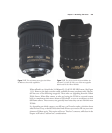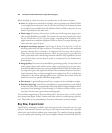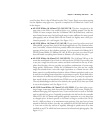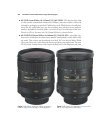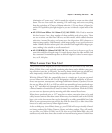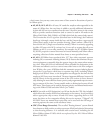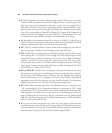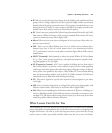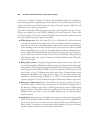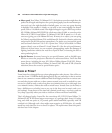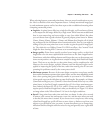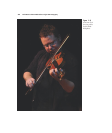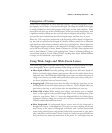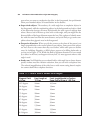
■ IF. Nikon’s internal focusing lenses change focus by shifting only small internal lens
groups with no change required in the lens’s physical length, unlike conventional
double helicoid focusing systems that move all lens groups toward the front or rear
during focusing. IF lenses are more compact and lighter in weight, provide better
balance, focus more closely, and can be focused more quickly.
■ IX. These lenses were produced for Nikon’s long-discontinued Pronea 6i and S APS
film cameras. While the Pronea could use many standard Nikon lenses, IX lenses
cannot be mounted on any Nikon digital SLR.
■ Micro. Nikon uses the term micro to designate its close-up lenses. Most other ven-
dors use macro instead.
■ NAI. This is not an official Nikon term, but it is widely used to indicate that a
manual focus lens is Not-AI, which means that it was manufactured before
1977, and therefore cannot be used safely on modern digital Nikon SLRs without
modification.
■ NOCT (Nocturnal). Used primarily to refer to the prized Nikkor AI-S Noct 58mm
f/1.2, a “fast” (wide aperture) prime lens, with aspherical elements, capable of tak-
ing photographs in very low light.
■ PC (Perspective Control). A PC lens is capable of shifting the lens from side to
side (and up/down) to provide a more realistic perspective when photographing
architecture and other subjects that otherwise require tilting the camera so that the
sensor plane is not parallel to the subject. Older Nikkor PC lenses offered shifting
only, but more modern models, such as the PC-E Nikkor 24mm f/3.5D ED lens
introduced early in 2008 allow both shifting and tilting.
■ UV. This term is applied to special (and expensive) lenses designed to pass ultra-
violet light.
■ UW. Lenses with this designation are designed for underwater photography with
Nikonos camera bodies, and cannot be used with Nikon digital SLRs.
■ VR. Nikon has an expanding line of vibration reduction (VR) lenses, including sev-
eral very affordable models, which shift lens elements internally to counteract cam-
era shake. The VR feature allows using a shutter speed up to four stops slower than
would be possible without vibration reduction.
What Lenses Can Do for You
I’m something of a lens nut. Because my work requires me to evaluate lots of different
lenses and provide recommendations for specific lenses that may have overlapping focal
lengths and features, I’m able to justify owning many more optics than the average
person wants or needs. It probably wouldn’t make sense for you to own 10-24mm,
Chapter 11 ■ Working with Lenses 357



